1875 - 2025
1811
Part of Cow Fen Leys (common pasture) enclosed by Thomas Hovell by an Act of Parliament.
1871
Full opening of the ancient universities to persons of every denomination.
1872
Suggestion by a group of Methodist laymen of a School and Undergraduate Hostel at Cambridge.
1874
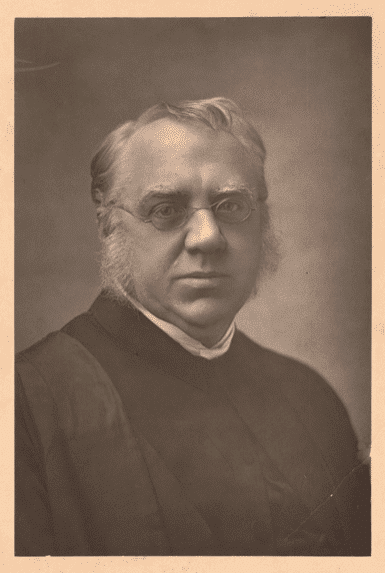
The Revd William Fiddian Moulton.
William Moulton was a distinguished academic theologian who came from a strong Methodist background, being descended from John Bakewell, one of John Wesley’s colleagues in the foundation of Methodism. A lecturer at the Methodist Training College in Richmond, William was asked by the Methodist Conference to chair the committee choosing a site for a new Methodist school for the children of laymen. After the site at The Leys was chosen William was appointed to be its first headmaster, despite his protestations. He would remain there until his death in 1898.
1876
Fourth term (20th January – April) 55 boys. Fifth term (beg. May for four weeks) 56 boys. The Leys Fortnightly started 31st May. Entries at Cambridge University. Dining Hall (later Art School) built.
1877
R. Curwen appointed architect. Kitchen built. OLFC started. Number of boys 100.
1878
West House finished. £30,000 loan raised. School incorporated (Charitable Trustees Incorporation Act, 1872). Natural History Society founded.

West House pictured 1911-1917.
1879
Great Hall, Music Rooms and Museum opened.


1884
Housekeeper appointed. First Directory published.
1885
South of England Lacrosse Championship won. Steward appointed.

1885 Whole School photo
1887
John Beauchamp, Hon. Treasurer. Farm and laundry acquired. Jan 1887, 143 boys.
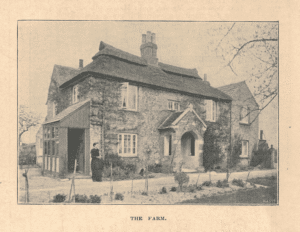

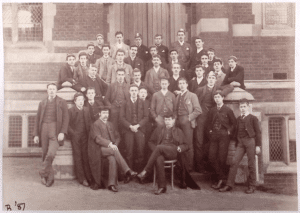
North B House members, 1887
1890
West House reopened. Sunday evening services at School. Dr. Moulton, President of Methodist Conference. Errol Street Mission opened.

1892
School House studies; classrooms over Dining Room. Number of Boys 200.
1896
Day-boys (later Home Boarders) admitted.
1897
Debt Relief inaugurated. Number of boys 145
1898
Death of Dr. Moulton. Dr. W.T.A. Barber appointed Headmaster.

The Revd William Barber taught briefly at the School (77-78) before becoming a lecturer at Richmond Theological College. From there he went as a missionary to China, becoming minister in charge of Hankow Christian College. He returned on the death of his wife and was staying in Manchester with the Claphams, where he married Emma, half-sister to the future Sir John Clapham, when he was appointed. He retired in 1919 and held the post of Provost for a year, but this experiment was abandoned.
1901
Cadet Corps instituted in 1901 with Jimmy Hurst Hayes, an Old Leysian (A 1891-94) and Master of the School (1899-1912), as first CO. Initially the Corps was affiliated to the 3rd (Cambs.) Volunteer Battalion Suffolk Regiment until 1909 when it became a contingent of the O.T.C. (Junior Division). The Company was designed to embrace, excluding bandsmen (bugles and drums), about half the School, being volunteer members and of sufficient age and physique.
Below: Some members of the Corps 1905 – Hayes seated centre
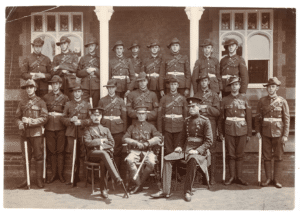
1905
Foundation Stone of School Chapel laid by H.R.H. The Duchess of Albany.
Moulton Scholarships founded.
Swimming Bath opened.
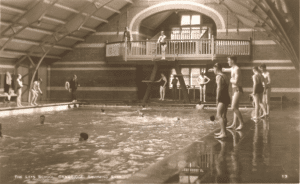
1906
Moulton Memorial Chapel opened.

1912
Hockey replaces Lacrosse.
OLFC as its zenith.
1915
Swimming Bath ceded to troops.
James Hilton entered School House (S 1915-18).
Hilton came from a Lancashire Methodist family and is particularly famous as the author of ‘Goodbye Mr Chips’. In his novel James partially modelled the central character on Balgarnie who had made a lasting impression on him. He made it clear that Mr Chipping was an amalgam of several masters, and his nickname came from another. However, he described Balgarnie as “the chief model of my story”. After the war, the novel was turned into a play in the West End and after one performance, to cries of “Author!”, Hilton came on stage. He pointed to one of the VIP boxes and much to the embarrassment of Balgarnie who was sitting in it, said: “And we have the real Mr Chips here with us tonight.”
1916
West House re-occupied.
War Commemoration Scheme.
1917
King’s Building completed and occupied.

1918
Lady Superintendent appointed. New scholarships offered. Number of boys 189.
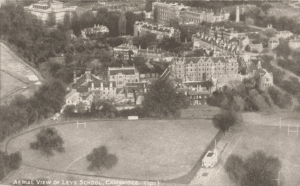
School site between 1914 and 1922 (King’s building built but no North A HsM house or 1923 Memorial Pavilion)
1919
No 5 & 6 Brookside purchased as Sanatorium and East House.
Ross Robertson Shield gifted in memory of J. Ross Robertson.
Number of boys 225.
Rev. Harry Bisseker appointed Headmaster. Bisseker had been school Chaplain from 1901-1904 and subsequently Chaplain to the Leysian Mission, so he understood The Leys well and was an obvious choice to replace Barber. He was increasingly subject to ill-health and in 1929 the Governors gave him leave of absence for a year whilst Balgarnie acted as Headmaster. However, Bisseker’s health gave way again and he retired in 1934.

1922
War Memorial (East Wall of Chapel) unveiled by H.R.H. The Duke of York. Housemaster’s house added to North A.

The war memorial was created after WWI following a fundraising campaign which financed the Mural Tablet in stone, on which were four panels with a central canopied figure of St. George in armour. The four panels held the names of the 149 Old Boys who gave their lives in the Great War. The memorial was unveiled by HRH the Duke of York on 6th July 1922. Under the statue of St. George was the inscription: “To the immortal memory of Old Leysians who fell in the war of 1914-1919,” while along the bottom of the Tablet, under the name panels, appear the following words : “My marks and scars I carry with me to be a witness for me that I have fought His battles, Who now will be my rewarder.” The architect was Mr. G. P. Hutchinson, of Messrs. James Cowell & Sons (Whitefriars), Ltd., Wigmore Street, London.
Two outer panels were added and unveiled in 1950 to commemorate Old Leysians who fought and died in the Second World War.
1925
School Jubilee. Old Leysians entertained for a week at the School. Jubilee Fund raised.
1926
From The Leys Fortnightly, vol. 50, no.885, 16 July 1926, p.326-327:
Very few buses have been available lately and the 1st XI went to Bedford in taxis last Saturday. The 2nd XI had an alarming experience on their way to Mill Hill on the same day. Trouble had been experienced with the steering gear, and while the bus was descending a hill the brakes failed. Luckily the driver managed to swerve on to a level and pull up gradually. The 2nd XI, however, decided to traverse the remaining two miles to Mill Hill afoot.
1927
New Science buildings opened by Sir J.J. Thomson, O.M. (Master of Trinity College). OLFC Jubilee.
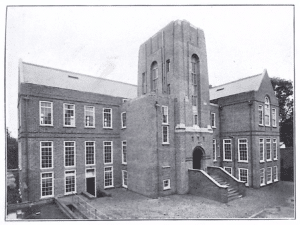
1929
New East House opened by Sir Joshua (later Lord) Stamp.
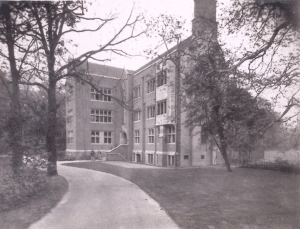
Seen from the north-west and Deer Park (photo acknowledgement to Marshall, Keene & Co, Hove)
1932
Informal visit of H.R.H. Prince of Wales (later King Edward VIII). H.R.H. opened the Fives courts, Squash courts and Miniature Shooting Range.
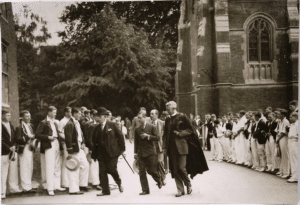
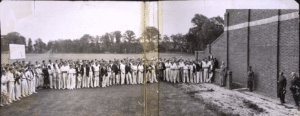
Fives Courts, Squash Courts, and Rifle Range building (situated behind West House).
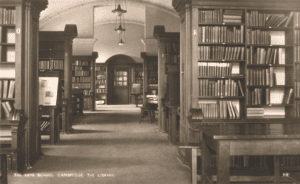
The last of the Library’s teak memorial bookcases were donated in 1932.
1935
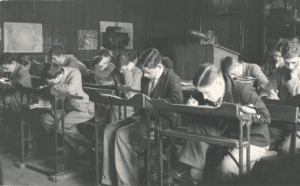
Boys studying Geography 1935/36
1937
Jubilee of The Leysian Mission. Housemaster’s house added to North B. Number of boys 227
1939
The Great Hall becomes the Dining Hall.
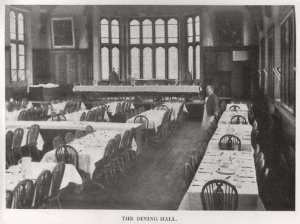
From The Leys Fortnightly Vol. 64, No.1110, 19 December 1939, p.62.

Memories of W. Neil White, School Prefect and Master Filename.ashx pp.115-119
1940
School premises requisitioned in August by the Ministry of Health as a Hospital.
In Autumn Term the School moved to the Atholl Palace Hotel, Pitlochry. The Leys Fortnightly continues to be printed in Cambridge during the School’s exile but with fewer pages due to paper shortages.

From The Leys Fortnightly Vol. 64, No.1111, 9 February 1940, p. 91. Performed in the December pantomime ‘Little Red Riding Hood’ written by D.W. Hughes (staff), A.T. Pepper and J.M.C. Pinkham (pupils). Balgarnie came out of retirement to teach again at Pitlochry during the war.
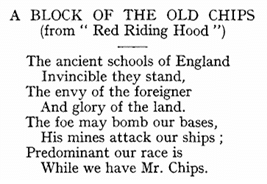
Sir Henry Dale OL appointed President of the Royal Society; Prof J H Clapham OL appointed President of The British Academy.
The film ‘The Leys Goes North’ is first mentioned in The Leys Fortnightly, shown to parents after the concert at Speech Day weekend.
1946
School returned to Cambridge in January. Number of boys 220.
1948
Donated by James Mitchell OL filmed by father Desmond OL.
1950
75th Anniversary Dinner in the School Hall.
Memorial Service and unveiling of the War Memorial panels for 1939-45.
Number of boys 303.
School Shooting VIII won the Ashburton Shield at Bisley, a competition established in 1861 by the 3rd Lord Ashburton, Francis Baring, and which The Leys had shot in since 1902. The 1950s were the ‘Golden Age’ of shooting at The Leys.
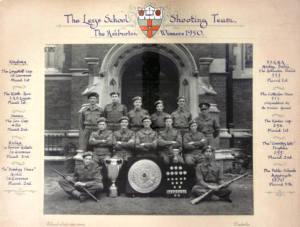
1954
House built in Newton Road for the School Chaplain.
1955
H.M. Queen Elizabeth the Queen Mother opened the new Hall at The Leysian Mission. Extension of East House completed with addition of the Manse. Number of boys 317.

East House (Stamp Building) with Manse added (© Edward Leigh, now Lafayette)
1958
Additional studies and changing rooms added to North A and B.
Kelvin Building extension completed.
W A Barker appointed as Headmaster.
William Alan Barker was born in Edinburgh in 1923 and married his wife Jean (later Baroness Trumpington) in 1954. Educated at Rossall and a Scholar of Jesus College, Cambridge, Alan obtained First Class Honours in both parts of the Historical Tripos. During the war he served in the Royal Artillery until wounded and invalided out. He was a master at Eton from 1947 to 1953 but held a Fellowship at Yale University, USA, from 1951-52. From 1953 to 1955 he was a Fellow of Queens’ College, Cambridge, and Director of Studies in History. In 1955 he returned to Eton before becoming Headmaster at The Leys in 1958. During his 17-year tenure The Leys became a much more liberal institution and saw tremendous improvement in buildings and facilities.
 |
1963
A survey of pupils’ use of leisure time published in The Leys Fortnightly in July 1963 revealed the following choice of newspaper by form group.

1965
Work started on the new Theatre, Music School and Fen House. Number of boys 356.
1923 Pavilion demolished. Foundation Stone of new Pavilion laid by F.R. Brown (OL).
1966
Construction of Lower Dining Hall and extensive alterations to School House.
Fen House occupied. New Pavilion in use.

(© Edward Leigh, now Lafayette)

(© John McCann)
1969
The War Game wins third prize in a BBC film competition
1972
Appeal launched to raise £150,000 for a new Teaching Block, Library Extension, a Careers and University Information Centre, additional accommodation for the Masters’ Common Room and the provision of study bedrooms in the North Houses. Work begins on new Classroom Block.
1973
H.M. Queen Elizabeth the Queen Mother unveiled a plaque on the unfinished new Classroom Block and gave permission for it to be named the Queen’s Building.
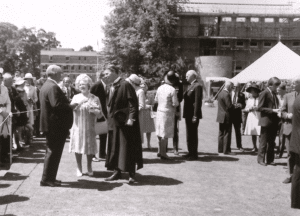
© Edward Leigh, now Lafayette
1976
Centenary of The Fortnightly.
Expedition to the Arctic Island of Spitsbergen led by Mr. R.H. Ward.
See special insert between pp.118-119 Filename.ashx
See expedition report pp.30-37 Filename.ashx
1977
Science Building re-opened (after refitting of services) by Mrs Charnock, daughter of Sir J.J. Thomson who originally opened it.
Centenary Dinner of the OLFC at the Café Royal.
1978
The Bisseker Room, a pastoral centre named after the School’s third Headmaster, and Chaplain’s Flat are opened at 6 Brookside.
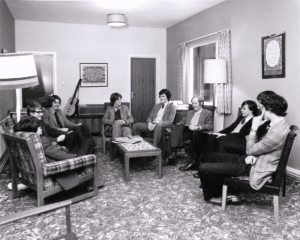
1979
New Careers Room opened by Lady Armitage. Number of boys 420.
1982
Computer Laboratory opened by The Rt. Hon. Patrick Jenkin (Secretary of State for Industry).
Governors decide to open the Sixth Form to girls from 1984.
1983
‘Ten Year Development Programme’ announced by Chairman of Governors, Sir Arthur Armitage.
Reconstructed Kitchens and Dining Hall opened by Lady Trumpington.
1984
First Rugg Prize winner attends the Dinner for the Knights of the Round Table at the Athenaeum.
First Girls’ Boarding House (Granta) opens in former Maids’ quarters.
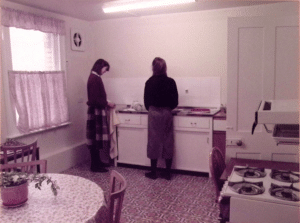

1987
Use of school well for supply of water ceased and, after extensive re-piping, buildings are connected to City water supply.
Dr. Max Perutz opened the new Biology Department (basement of the Science Block).
H.R.H. The Duke of Edinburgh opens the Rugg Centre, a new Art, Design and Technology building.


1988
Service in School Chapel to commemorate the 250th Anniversary of the conversion of John Wesley.
Conversion of Kelvin Building to house Geography, History and Economics departments.
First GCSE examinations. Cricket Tour to Barbados, West Indies.
1990
Hockey Tour of USA and Canada. Number of pupils 388.
Rev. J.C.A. Barrett M.A. appointed Headmaster.
Reverend J. C. A. Barrett became the School’s eighth Headmaster in August 1990. John had been Headmaster of Kent College, Pembury. During his 14 years at The Leys the School extended co-education to 13-18 years; established The Leys Foundation with St Faith’s, having a common Board of Governors; introduced a small junior house with entry at Year 7/8; refurbished existing builds and added a new Sports Centre and Humanities Block; as well as increasing pupil numbers by more than a third.

1994
The introduction of co-education throughout the 13-18 range.
Fen House re-opens as a 13-18 Girls Boarding House.
1996
Sports Tour of South Africa – Hockey and Rugby.
Dale House increased in size to take 55 girls, age 13-18.
1997
Introduction of Day pupils in addition to Home Boarders and Boarders.
North B House opened by Lord Lewis, Chairman of Governors as a mixed day House.
Refurbished East House opened by P.R. Lacey (former Housemaster) as a Boys’ Sixth Form Boarding House.
Girls’ Hockey tour to Boston, USA.
1998
IT satellite and Junior Library extension opened by Baroness James (P.D. James) on Speech Day
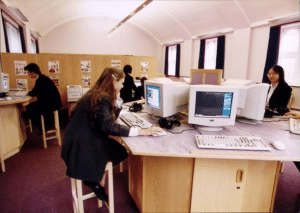

Introduction of Year 7 pupils. Moulton House for Year 7 and 8 pupils opened in 6 Brookside, September. Number of pupils 465.
The Stamp Building houses both the Modern Languages Department and East House and new Bisseker Room.
2001
Joint Boys’ and Girls’ Hockey Tour to South Africa.
2002
The new Clapham Building comes into use for Classics, Divinity, History and Geography. Formal Re-opening of the Science Building on its Seventy-fifth Anniversary.
Number of pupils 530.
2003
Visit of the Duke of Edinburgh to formally open the Clapham Building.

2004
Construction of new music school begins.
School Choir Singing Coe Fen:
Africa expedition. Rugby Tour to South Africa.
Mr M Slater appointed Headmaster. Educated at Wellington College Mark took his degree at St Edmund Hall, Oxford, and his PGCE at King’s College, London. After his first teaching post at Lord Wandsworth College he returned to Wellington to be a Head of Department and Housemaster. He joined The Leys in September 2004 having previously been Headmaster at St. Lawrence College, Ramsgate, for eight years. During his nine year tenure at The Leys the School grew in numbers, saw significant improvement in academic results, underwent numerous refurbishments of buildings and boarding houses, and constructed the ambitious Great Hall theatre with its new science laboratories.

2006
Sports Hall Extension opened. Refurbishment of East House.

Celebrations to mark the Centenary of the Chapel, and publication of The Chapel: A Brief History by John Harding.
Africa expedition.
2009
New lighting installed in Chapel.
Cricket Tour to South Africa.
The Leys are Daily Mail RBS U15s Vase winners at Twickenham.

© Kickphoto
2010
Dale House two-year refurbishment completed.
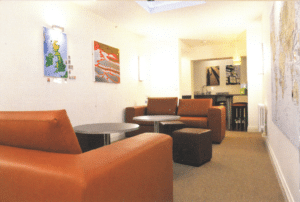


The new Chairman of Governors is Sir Tony Brenton KCMG.
Boys’ Hockey and Rugby tour to Singapore, Malaysia and Australia.
Additional School Prefects for Chapel, Community, Culture and Sport are appointed for the first time.
2013
Great Hall and new science laboratories come into use.

School House two-year refurbishment completed. Number of pupils 565.
Africa expedition.
2015
First female Senior Deputy Head appointed, Mrs C. Emma Mayo.
North A House two-year refurbishment completed. Queen’s Building Drama Studio converted to classrooms. The Moulton Room converted to offices for Admissions and Headmaster’s P.A., including a waiting area and meeting room.
The Leys reaches the Hockey Association boys’ U16 National Finals.
Africa expedition. Boys’ Hockey and Rugby Tour to South Africa.
2016
New Combined Colleges Boathouse opens on the river Cam, shared with Churchill, King’s and Selwyn.
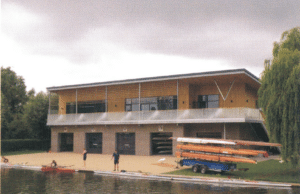
Climbing expedition to Croatia. Outdoor Education Himalayan expedition.
Publication of A Very Christian Friendship: William Moulton and the Broad Church in Cambridge by John Harding.
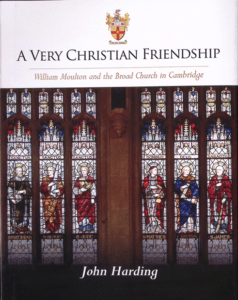
2017
West House two-year refurbishment completed.


iPads issued to pupils. Implementation of EPQ (Extended Project Qualification) for Sixth Formers.
The Leys reaches the Hockey Association girls’ U16 National Finals.
Africa expedition. Boys’ Cricket Tour to Sri Lanka.
2020
Government efforts to control the Covid-19 pandemic begin in March with a significant impact on normal School operations. School closed summer term 2020 due to national ‘lockdown’ with remote teaching in place.
The Leys reaches the Hockey Association girls’ U16 and U18 National Finals.
2021
School closed for part of Lent term in second ‘lockdown’. Old Leysian Assynt Camp reunion postponed twice due to Covid-19 pandemic.
The Leys reaches the U18 T20 Cricket National Finals.
2022
School routines return to near normal in September following Covid-19 interventions. Number of pupils 574.
The Leys plays their first girls’ cricket fixture against the MCC in a T20 match.

In the ISI School Inspection, The Leys was rated ‘Excellent’.
2024
The Cedar of Lebanon on the Headmaster’s lawn succumbs to waterlogged ground in February and topples over.

The Leys School is named East Anglia’s Independent School of the Year by The Sunday Times Parent Power Guide 2024.

1815
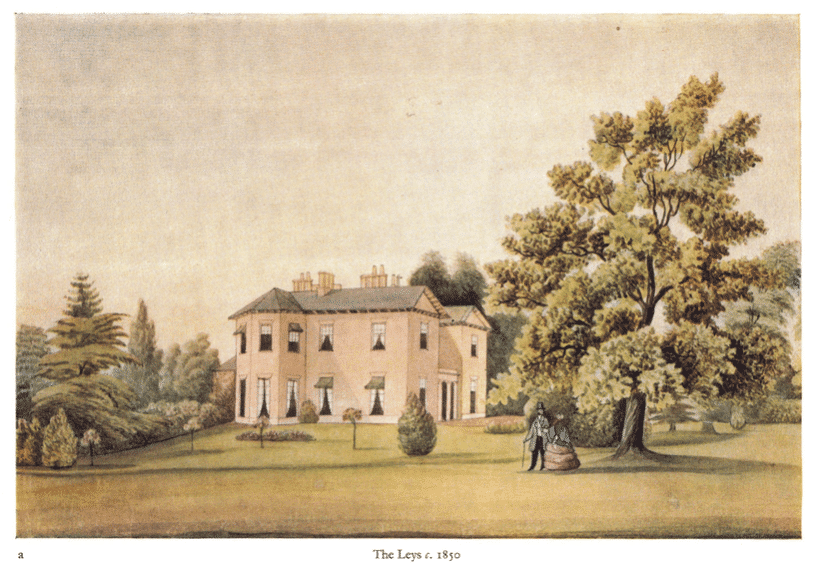
A private house built on ‘The Leys Estate’.
1873
Estate provisionally secured and Governing Body formed.
1875
School opened, 16 February, Inauguration 11 March. 16 boys.
The School opened on February 16 1875 with 16 pupils. It was hardly an auspicious start. but nevertheless it managed to grow and flourish. It helped that the original XVI included members of many prominent Methodist families spread over the country. The two prefects came from the West country. Others hailed from Bristol, Manchester, Newcastle and Northern Ireland. There was one of Alexander McArthur’s sons, and Willliam Moulton’s eldest son, James Hope Moulton. Joseph Richards travelled from far-flung South Africa, and was to play cricket for that country, before it became a Test nation. Almost every boy was followed by further family members.
‘ORIGINAL XVI’: J.C. Isard, R.A.H. Bickford-Smith (Prefects), H.G. Atkinson, H.Benson, I. Blore, W.S. Ellis, J.L.B. Gedye, W.J. Jenks, R.G. Lindsay, J.P. McArthur, J.H. Matthews, J.H. Moulton, H.T. Parke, J.M. Richards, R.M. Richardson, W.G. Richardson. The last survivor, H. Benson, died in 1953.

Dormitories, School-room and Class-room built during first term (16th February – 12th April 1875).
Second term (beg. May to 26th July) 30 boys. Temporary Gymnasium in use from June; Coach House converted to laboratory; workshop set up.
Third term (17th September – 20th December) 41 boys.

The Leys’s first competitive school cricket match was played on Parker’s Piece vs Perse School on 12th June 1875. The Leys were soundly beaten but it was a start.
1880
First OL Cambridge honours degree, first OL Dinner. North Block built, ‘A’ opened. Running track and Cricket pavilion completed.
1881
First Tuck Shop opened.
1882
Third successive Invicti XV. Christian and OL Unions formed. Entrance scholarships were introduced.
1883
Lacrosse adopted. North Block finished, ‘B’ opened.

OLFC beat Cardiff and Cambridge University. West House temporarily closes (till 1890).
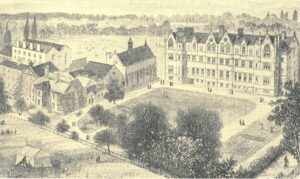
An early drawing of the School site.
1886
Leysian Mission founded at Whitecross Street. School Secretary appointment.
The Leys Christian Union first discussed the desirability of opening up a Mission in the East End of London in 1885. It was very much the practice for public schools in the last quarter of the century to establish such missions, inspired by Uppingham’s example under the leadership of its headmaster, Edward Thring. The proposal had the strong backing of McArthur, who provided many of the original organisers. It opened in Whitecross Street in 1886, with Frank Holman, one of Alexander McArthur’s sons-in-law, as its first secretary.

1888
Games made compulsory.
1889
Games Pavilion, Sanatorium, Organ Gallery, Water Plant.

1891
Sir George Hayter, hon. Treasurer.
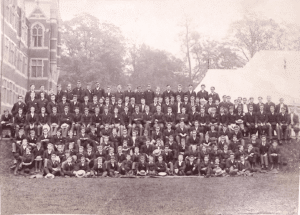
1891/92 Whole School photo.
1893
Science School opened by Lord Kelvin. Museum equipped. Tuck Shop moved next to Fives Courts.

1900
City Road Mission site bought.
William H Balgarnie joins the School.

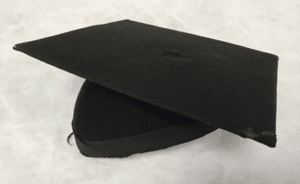
Balgarnie’s Mortarboard in the School Archive
A young man joined The Leys in 1900 who was to become possibly its most famous master. Balgarnie, whose nickname was ‘Uncle’, taught Classics until 1930, was Housemaster of West from 1901 to 1929, and Acting Headmaster in his final year, retired to live in Brookside, and was then summoned back in 1940 to teach at Pitlochry during WWII, retiring again in 1946. He died in 1951. After his first retirement he was well known for inviting all new boys across to Brookside and telling them stories about their fathers (or grandfathers) whom he had known as boys.
1904
New Mission (costing nearly £100,000 paid for by former and current Leysians of the day) and Caldicott Preparatory School opened.

Caldicott Preparatory School opened in Lent Term 1904 with 12 pupils, almost all the sons of well-known Old Leysians. The School’s first Headmaster was James H Jenkins, himself an Old Leysian (S 1888-94) and former Leys Master (1901-03).
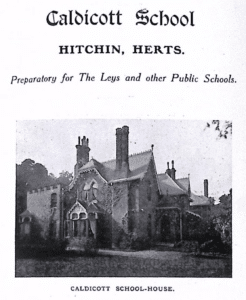
1907
Foundation Stone of Gymnasium Block laid by Sir Henry Campbell-Bannerman.

1914
H.M. King George V inaugurated the Library Block (The King’s Building). Architect Sir Aston Webb, P.R.A.
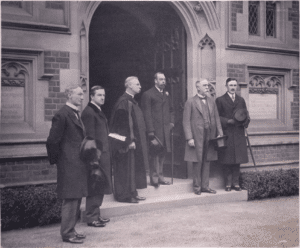
L-R: J.H.S. McArthur J.P. (OL & Hon Sec to Governors), Maj. Clive Wigram (Equerry), Rev. Dr. W.T.A. Barber (Headmaster), HM King George V, Sir George Hayter Chubb Bt J.P. (Chairman of Governors), Capt. Godfrey Faussett (Equerry).
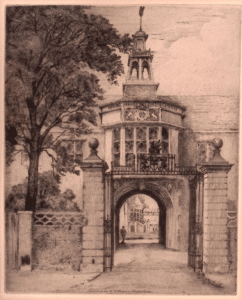
Kings Gateway – Piper/Hayes etching
School became a temporary Military Hospital in August.
West House evacuated.
New official school Coat of Arms assigned.

1920
Sanatorium opened.
1921
Visit of The Crown Prince of Japan.
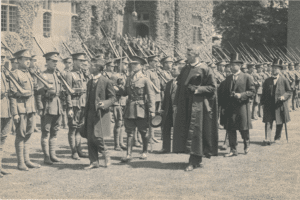


1923
New pavilion (War Memorial) opened. West House remodelled. Old Leysian Lodge consecrated. The Leys Endowment Fund.

1924
New Isolation House and Sanatorium Extension (War Memorial) opened by Sir Henry Dale.
Number of boys 250.
From The Leys Fortnightly 3rd October 1924 (Vol. 49, No. 852) School Notes:
“The School is to be congratulated upon making the acquaintance of Muller’s Five-minute course of exercises, which it endeavours to perform every morning during the rather long five minutes between 12.25 and 12.45.”

Drill session from 1934 (© Sport & General Press Agency)
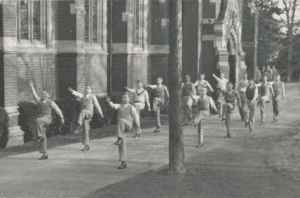
1928
Bursary and Office removed to Old Science Block (Kelvin Building).
1930
New Playing Fields, Latham Road, purchased (19 ½ acres). Number of boys 271.

1934
Scout Hut opened by Chief Scout Commissioner.
Dr. W.G. Humphrey appointed Headmaster. Among Humphrey’s great achievements are the purchase in 1938 of St Faith’s as a preparatory school for The Leys, and masterminding the relocation of the school and many of its staff to the Atholl Palace Hotel, Pitlochry, during WWII. His portrait painting features a map of Scotland in recognition of this enormous undertaking.

1936
Public Schools Lodge Masonic Festival at the school.

From The Leys Fortnightly, Vol. 60, No. 1048, 28 February 1936, p.168
1938
Diamond Jubilee of OLFC.
St Faith’s Preparatory School acquired by the Governors of The Leys School.
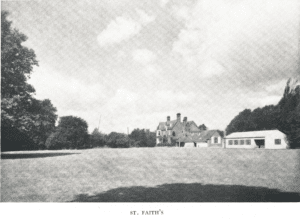
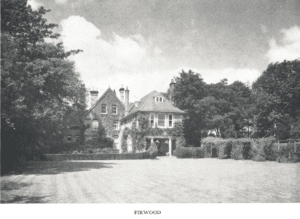
1941
October – the first female member of teaching staff joins the school; Miss M.M. Godwin teaches French, replacing N.P. Wright who was absent on war service.
1942
October – a second female teacher, Miss F.H. Sutton, joins the school as Senior Physics Mistress, from Wycombe Abbey School.
1943
A third female teacher joins the school in February; Miss M.M. Weemys replaces Miss Godwin teaching French. Number of Boys 170.
1944
PT on the hotel terrace at Pitlochry
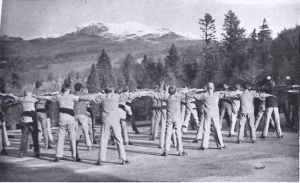
1945
From The Leys Fortnightly Vol. 69, No.1153, 22 March 1945, p. 74.

October – number of boys 215.
1949
Cairn with indicator on Ben-y-Vrackie in memory of ‘Years of Exile’.
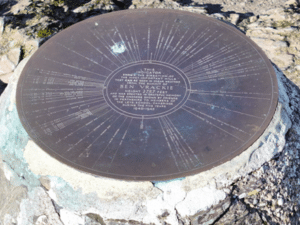
1953
Visit of H.M. Queen Salote of Tonga, in the UK for Queen Elizabeth II’s Coronation. The Leys has a long association with Tonga where our first Headmaster’s brother, Rev. James E. Moulton, was a Methodist missionary who established Tupou College in 1866.

Camfield Press is started by a pupil and Mr Southern. For the next 55 years it prints a variety of publications for the School, from booklets to theatre programmes and tickets.
A pupil from the 1960s reminisces about his time spent in the Press.
School Shooting VIII won Ashburton Shield again.

1957
Appeal Fund launched to raise £100,000 to enable much-needed maintenance and development of school buildings. Kelvin Building extension begun.
1959
Swimming Bath rebuilt and work begun on new West House.
1961
New West House opened on 6 June by H.M. Queen Elizabeth the Queen Mother.


Old West House adapted to become School Sanatorium. No. 5 Brookside (Sanatorium) and Isolation Block sold.
Top of old West House becomes Art department. Number of boys 358.
1964
Appeal launched to raise £200,000 to build a new boarding house, theatre/assembly hall, and music school. 200 contributors raise more than half the total in three months.

Aerial photograph of St Faith’s taken from a 1964 St Faith’s Prospectus
1967
Formal opening of the new buildings on 19 June by Sir Arthur Armitage (Vice-Chancellor of Cambridge University).
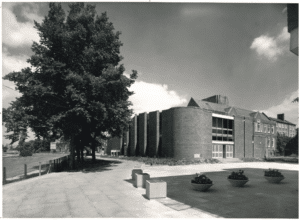
The new theatre (© Edward Leigh, now Lafayette)
King’s Building and School Chapel scheduled as buildings of historic or architectural interest.
1968
The School combines with King’s, Selwyn and Churchill Colleges to build a boat house.
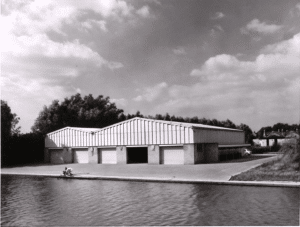
© Edward Leigh, now Lafayette
1970
Number of boys 408.
Film created on the making of The Leys Fortnightly.
1974
Study bedrooms created in North Houses and additional studies in School House.
1975
Centenary celebrations in February include a luncheon for School, dinner for Governors, Staff and Guests, and a Centenary Service in King’s College Chapel with the exhortation read by Rev. H.K. Moulton D.D. OL, grandson of the first Headmaster. A Centenary Dinner for Old Leysians was held in the Guildhall, Cambridge, in October.

Publication of Partnership in Excellence: A Late-Victorian Educational Adventure: The Leys School, Cambridge 1875-1975 by Derek Baker.
Library extension opened by H.R.H. the Duchess of Kent in July. Number of boys 422.
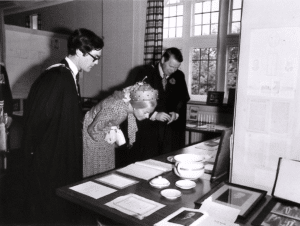
© Cambridge Evening News
Mr B.T. Bellis M.A., F.R.S.E. appointed Headmaster.
Bertie Bellis was educated at Kingswood School and St. John’s College, Cambridge, where he was a Mathematical Exhibitioner. He started his teaching career in 1951 at Rossall School, moving to Highgate School to become Head of Mathematics and later a Housemaster until 1965. He was then appointed Headmaster of Daniel Stewart’s College, Edinburgh and Principal of the joint establishment consisting of 1450 boys when it merged with Melville College in 1972. From 1971-2 he was President of the Mathematical Association and was elected a Fellow of The Royal Society of Edinburgh in 1972. With his Methodist background he followed in the footsteps of our first three Headmasters, guiding The Leys through a time of national economic difficulty, overseeing internal refurbishments and the introduction of girls into the Sixth Form.
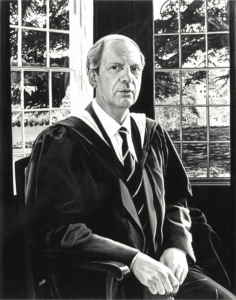
1985
Reunion at the Atholl Palace, Pitlochry to celebrate 40 years since the return of the School from Scotland.

Rugby Tour of Australia lasting 30 days, the first overseas tour for several decades.
Sir Percy Rugg (OL) lays Foundation Stone of the Rugg Centre. Number of pupils 402.
1986
Swimming Bath has completely new-re-designed roof. First Lower Sixth Reading Party.
T.G. Beynon M.A., F.R.G.S. appointed Headmaster.
Tim Beynon joined The Leys in April 1986. Since 1978 he had been Headmaster of Denstone College, one of the Woodard schools, which had become co-educational during his time there. Tim read Mathematics and Mechanical Sciences at King’s College, Cambridge. After completing his postgraduate Certificate in Education, he taught Mathematics at the City of London School and Merchant Taylors’ School, becoming a Housemaster and Senior Master before moving to Denstone College. His tenure was comparatively short but saw improvements in A Level results and the expansion of girls in Sixth Form via conversions to buildings

1989
Ross Robertson Shield stolen.
Medical Centre moves into Tuck Shop Building, School House moves into refurbished original West House and Second Girls’ Boarding House (Dale) opens in the former School House building. Number of girls 53.
1992
Rugby Tour of Australia.
Development Campaign started with new Sports Hall as first project.
1993
Fen House closed. Drama Tour to Australia.
Construction of new Sports Hall begins at end of year/early 1994.
1995
Sports Hall opened in September by H.R.H the Duchess of Kent.
Mrs. C. White opened the Neil White Memorial All-weather surface.

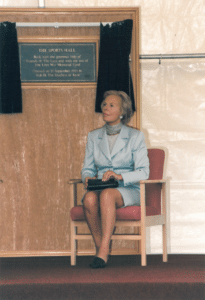
North A re-opened by David Green (OL), Director of VSO, after refurbishment.
Number of pupils 424.
1999
Rugby Tour to South Africa.
Pitlochry plaque unveiled in the Library to commemorate the School’s ‘exile’ during the Second World War.
2000
125th Anniversary of the Foundation of The Leys: Service of Thanksgiving in Great St. Mary’s.
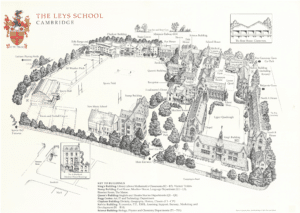
Publication of Well-regulated Minds and Improper Moments by Geoff and Pat Houghton.
The curious title for this book is taken from a line that, for nearly a century, was repeatedly written out by boys at The Leys as a punishment:
“Few things are more distressing to a well-regulated mind than to see a boy who ought to know better desporting himself at improper moments.”
E.E. Kellett (Leys Staff 1889-1924)

First Assynt Camp Re-union; former Leys Scouts and Scout Leaders return to a favourite scout camp site at Loch Assynt in Scotland.
2005
North B re-opens as three separate day houses: Barker, Bisseker and Barrett. Refurbishment of the Dining Hall.
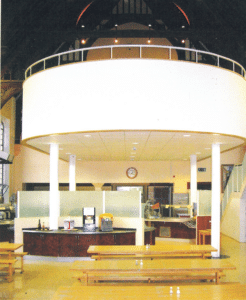
Africa expedition.
Opening of the new Music School by Julian Lloyd-Webber.

2007
Refurbishment of Granta. Phase one of Library refurbishment.
Rugby Tour to New Zealand. Girls’ Hockey and Netball Tour to Malaysia.
Africa expedition.
2008
Opening of the new Cricket Pavilion and extension on Sports Hall. New Astro-turf pitch at Latham.
Refurbishment of Fen House. Phase two and completion of the Library refurbishment.
Number of pupils 548.
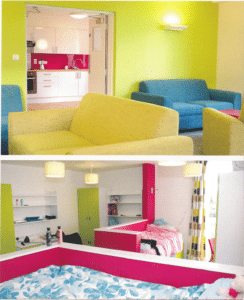

2011
Theatre demolished to make way for new theatre (Great Hall) and three new science laboratories.
Africa expedition.
2012
The Leys 1st XV are Daily Mail RBS U18s Vase winners at Twickenham.

Publication of A Methodist Education: The Leys under Moulton and Barber 1875–1924 by John Harding.
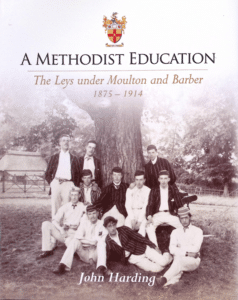
2014
Mr M. J. Priestley appointed Headmaster from January.
Martin Priestley was educated at Repton and studied PPE at Oxford University. He spent 12 years at Uppingham in the Politics Department teaching Economics and a little History, and for eight of those years was also a Housemaster. He then became Headmaster of Warminster School for nearly eight years.
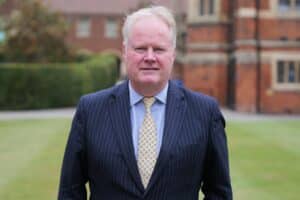
Prince Edward formally opens Great Hall. ‘Transition Point’ sculpture unveiled.
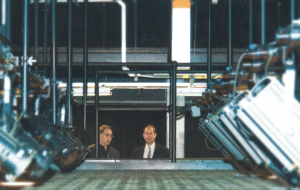
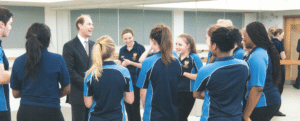
The old Dance Studio becomes the James Hilton Room.
The Academic Prefect is added to the Prefect team to represent academic issues.
Outdoor Education Expedition to India.
Publication of The Leys in the Era of World War: A History of The Leys 1914–1950 by John Harding.

2018
New organ installed in the Chapel and choir stalls repositioned to face the congregation. Music Tour to Croatia and Slovenia. Number of pupils 560.
The Wellbeing Prefect was added to the Prefect team.
The Leys reaches the Hockey Association girls’ U16 National Finals. The Leys reaches the U15 National Squash Finals. The first girls’ cricket fixtures against school opposition are played.
Outdoor Education Himalayan expedition. Year 10 Science trip to Canada.
2019
Refurbishment of swimming pool changing rooms and pool surround.
East House two-year refurbishment completed.

Vision Studio opened for pupil use.

The Leys Chamber Choir recorded Earthly and Divine.
The Lamb:
Africa expedition. Boys’ Rugby and Hockey Tour of South Africa.
2023
The senior boys’ swimming team won the Dunelm Cup (small schools’ medley relay) at The Bath Cup Competition in London. The Leys last won this event in 1939.

The U16 boys’ Rugby Sevens team reached the semi-final of the Rosslyn Park Tournament.
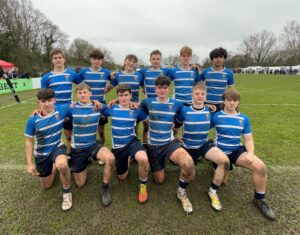
The new Chairman of Governors is Sir Matthew Rycroft KCMG CBE.
2025
The Leys School is named in the top 100 independent schools in the country by The Sunday Times Parent Power Guide 2025, achieving the 92nd position, the highest ranking on record.
Number of pupils 565.
The School appoints its first female Headteacher, Dr Clare Ives, for September 2025.

1811
Part of Cow Fen Leys (common pasture) enclosed by Thomas Hovell by an Act of Parliament.
1815

A private house built on ‘The Leys Estate’.
1871
Full opening of the ancient universities to persons of every denomination.
1872
Suggestion by a group of Methodist laymen of a School and Undergraduate Hostel at Cambridge.
1873
Estate provisionally secured and Governing Body formed.
1874

The Revd William Fiddian Moulton.
William Moulton was a distinguished academic theologian who came from a strong Methodist background, being descended from John Bakewell, one of John Wesley’s colleagues in the foundation of Methodism. A lecturer at the Methodist Training College in Richmond, William was asked by the Methodist Conference to chair the committee choosing a site for a new Methodist school for the children of laymen. After the site at The Leys was chosen William was appointed to be its first headmaster, despite his protestations. He would remain there until his death in 1898.
1875
School opened, 16 February, Inauguration 11 March. 16 boys.
The School opened on February 16 1875 with 16 pupils. It was hardly an auspicious start. but nevertheless it managed to grow and flourish. It helped that the original XVI included members of many prominent Methodist families spread over the country. The two prefects came from the West country. Others hailed from Bristol, Manchester, Newcastle and Northern Ireland. There was one of Alexander McArthur’s sons, and Willliam Moulton’s eldest son, James Hope Moulton. Joseph Richards travelled from far-flung South Africa, and was to play cricket for that country, before it became a Test nation. Almost every boy was followed by further family members.
‘ORIGINAL XVI’: J.C. Isard, R.A.H. Bickford-Smith (Prefects), H.G. Atkinson, H.Benson, I. Blore, W.S. Ellis, J.L.B. Gedye, W.J. Jenks, R.G. Lindsay, J.P. McArthur, J.H. Matthews, J.H. Moulton, H.T. Parke, J.M. Richards, R.M. Richardson, W.G. Richardson. The last survivor, H. Benson, died in 1953.

Dormitories, School-room and Class-room built during first term (16th February – 12th April 1875).
Second term (beg. May to 26th July) 30 boys. Temporary Gymnasium in use from June; Coach House converted to laboratory; workshop set up.
Third term (17th September – 20th December) 41 boys.

The Leys’s first competitive school cricket match was played on Parker’s Piece vs Perse School on 12th June 1875. The Leys were soundly beaten but it was a start.
1876
Fourth term (20th January – April) 55 boys. Fifth term (beg. May for four weeks) 56 boys. The Leys Fortnightly started 31st May. Entries at Cambridge University. Dining Hall (later Art School) built.
1877
R. Curwen appointed architect. Kitchen built. OLFC started. Number of boys 100.
1878
West House finished. £30,000 loan raised. School incorporated (Charitable Trustees Incorporation Act, 1872). Natural History Society founded.

West House pictured 1911-1917.
1879
Great Hall, Music Rooms and Museum opened.


1880
First OL Cambridge honours degree, first OL Dinner. North Block built, ‘A’ opened. Running track and Cricket pavilion completed.
1881
First Tuck Shop opened.
1882
Third successive Invicti XV. Christian and OL Unions formed. Entrance scholarships were introduced.
1883
Lacrosse adopted. North Block finished, ‘B’ opened.

OLFC beat Cardiff and Cambridge University. West House temporarily closes (till 1890).

An early drawing of the School site.
1884
Housekeeper appointed. First Directory published.
1885
South of England Lacrosse Championship won. Steward appointed.

1885 Whole School photo
1886
Leysian Mission founded at Whitecross Street. School Secretary appointment.
The Leys Christian Union first discussed the desirability of opening up a Mission in the East End of London in 1885. It was very much the practice for public schools in the last quarter of the century to establish such missions, inspired by Uppingham’s example under the leadership of its headmaster, Edward Thring. The proposal had the strong backing of McArthur, who provided many of the original organisers. It opened in Whitecross Street in 1886, with Frank Holman, one of Alexander McArthur’s sons-in-law, as its first secretary.

1887
John Beauchamp, Hon. Treasurer. Farm and laundry acquired. Jan 1887, 143 boys.



North B House members, 1887
1888
Games made compulsory.
1889
Games Pavilion, Sanatorium, Organ Gallery, Water Plant.

1890
West House reopened. Sunday evening services at School. Dr. Moulton, President of Methodist Conference. Errol Street Mission opened.

1891
Sir George Hayter, hon. Treasurer.

1891/92 Whole School photo.
1892
School House studies; classrooms over Dining Room. Number of Boys 200.
1893
Science School opened by Lord Kelvin. Museum equipped. Tuck Shop moved next to Fives Courts.

1896
Day-boys (later Home Boarders) admitted.
1897
Debt Relief inaugurated. Number of boys 145
1898
Death of Dr. Moulton. Dr. W.T.A. Barber appointed Headmaster.

The Revd William Barber taught briefly at the School (77-78) before becoming a lecturer at Richmond Theological College. From there he went as a missionary to China, becoming minister in charge of Hankow Christian College. He returned on the death of his wife and was staying in Manchester with the Claphams, where he married Emma, half-sister to the future Sir John Clapham, when he was appointed. He retired in 1919 and held the post of Provost for a year, but this experiment was abandoned.
1900
City Road Mission site bought.
William H Balgarnie joins the School.


Balgarnie’s Mortarboard in the School Archive
A young man joined The Leys in 1900 who was to become possibly its most famous master. Balgarnie, whose nickname was ‘Uncle’, taught Classics until 1930, was Housemaster of West from 1901 to 1929, and Acting Headmaster in his final year, retired to live in Brookside, and was then summoned back in 1940 to teach at Pitlochry during WWII, retiring again in 1946. He died in 1951. After his first retirement he was well known for inviting all new boys across to Brookside and telling them stories about their fathers (or grandfathers) whom he had known as boys.
1901
Cadet Corps instituted in 1901 with Jimmy Hurst Hayes, an Old Leysian (A 1891-94) and Master of the School (1899-1912), as first CO. Initially the Corps was affiliated to the 3rd (Cambs.) Volunteer Battalion Suffolk Regiment until 1909 when it became a contingent of the O.T.C. (Junior Division). The Company was designed to embrace, excluding bandsmen (bugles and drums), about half the School, being volunteer members and of sufficient age and physique.
Below: Some members of the Corps 1905 – Hayes seated centre

1904
New Mission (costing nearly £100,000 paid for by former and current Leysians of the day) and Caldicott Preparatory School opened.

Caldicott Preparatory School opened in Lent Term 1904 with 12 pupils, almost all the sons of well-known Old Leysians. The School’s first Headmaster was James H Jenkins, himself an Old Leysian (S 1888-94) and former Leys Master (1901-03).

1905
Foundation Stone of School Chapel laid by H.R.H. The Duchess of Albany.
Moulton Scholarships founded.
Swimming Bath opened.

1906
Moulton Memorial Chapel opened.

1907
Foundation Stone of Gymnasium Block laid by Sir Henry Campbell-Bannerman.

1912
Hockey replaces Lacrosse.
OLFC as its zenith.
1914
H.M. King George V inaugurated the Library Block (The King’s Building). Architect Sir Aston Webb, P.R.A.

L-R: J.H.S. McArthur J.P. (OL & Hon Sec to Governors), Maj. Clive Wigram (Equerry), Rev. Dr. W.T.A. Barber (Headmaster), HM King George V, Sir George Hayter Chubb Bt J.P. (Chairman of Governors), Capt. Godfrey Faussett (Equerry).

Kings Gateway – Piper/Hayes etching
School became a temporary Military Hospital in August.
West House evacuated.
New official school Coat of Arms assigned.

1915
Swimming Bath ceded to troops.
James Hilton entered School House (S 1915-18).
Hilton came from a Lancashire Methodist family and is particularly famous as the author of ‘Goodbye Mr Chips’. In his novel James partially modelled the central character on Balgarnie who had made a lasting impression on him. He made it clear that Mr Chipping was an amalgam of several masters, and his nickname came from another. However, he described Balgarnie as “the chief model of my story”. After the war, the novel was turned into a play in the West End and after one performance, to cries of “Author!”, Hilton came on stage. He pointed to one of the VIP boxes and much to the embarrassment of Balgarnie who was sitting in it, said: “And we have the real Mr Chips here with us tonight.”
1916
West House re-occupied.
War Commemoration Scheme.
1917
King’s Building completed and occupied.

1918
Lady Superintendent appointed. New scholarships offered. Number of boys 189.

School site between 1914 and 1922 (King’s building built but no North A HsM house or 1923 Memorial Pavilion)
1919
No 5 & 6 Brookside purchased as Sanatorium and East House.
Ross Robertson Shield gifted in memory of J. Ross Robertson.
Number of boys 225.
Rev. Harry Bisseker appointed Headmaster. Bisseker had been school Chaplain from 1901-1904 and subsequently Chaplain to the Leysian Mission, so he understood The Leys well and was an obvious choice to replace Barber. He was increasingly subject to ill-health and in 1929 the Governors gave him leave of absence for a year whilst Balgarnie acted as Headmaster. However, Bisseker’s health gave way again and he retired in 1934.

1920
Sanatorium opened.
1921
Visit of The Crown Prince of Japan.



1922
War Memorial (East Wall of Chapel) unveiled by H.R.H. The Duke of York. Housemaster’s house added to North A.

The war memorial was created after WWI following a fundraising campaign which financed the Mural Tablet in stone, on which were four panels with a central canopied figure of St. George in armour. The four panels held the names of the 149 Old Boys who gave their lives in the Great War. The memorial was unveiled by HRH the Duke of York on 6th July 1922. Under the statue of St. George was the inscription: “To the immortal memory of Old Leysians who fell in the war of 1914-1919,” while along the bottom of the Tablet, under the name panels, appear the following words : “My marks and scars I carry with me to be a witness for me that I have fought His battles, Who now will be my rewarder.” The architect was Mr. G. P. Hutchinson, of Messrs. James Cowell & Sons (Whitefriars), Ltd., Wigmore Street, London.
Two outer panels were added and unveiled in 1950 to commemorate Old Leysians who fought and died in the Second World War.
1923
New pavilion (War Memorial) opened. West House remodelled. Old Leysian Lodge consecrated. The Leys Endowment Fund.

1924
New Isolation House and Sanatorium Extension (War Memorial) opened by Sir Henry Dale.
Number of boys 250.
From The Leys Fortnightly 3rd October 1924 (Vol. 49, No. 852) School Notes:
“The School is to be congratulated upon making the acquaintance of Muller’s Five-minute course of exercises, which it endeavours to perform every morning during the rather long five minutes between 12.25 and 12.45.”

Drill session from 1934 (© Sport & General Press Agency)

1925
School Jubilee. Old Leysians entertained for a week at the School. Jubilee Fund raised.
1926
From The Leys Fortnightly, vol. 50, no.885, 16 July 1926, p.326-327:
Very few buses have been available lately and the 1st XI went to Bedford in taxis last Saturday. The 2nd XI had an alarming experience on their way to Mill Hill on the same day. Trouble had been experienced with the steering gear, and while the bus was descending a hill the brakes failed. Luckily the driver managed to swerve on to a level and pull up gradually. The 2nd XI, however, decided to traverse the remaining two miles to Mill Hill afoot.
1927
New Science buildings opened by Sir J.J. Thomson, O.M. (Master of Trinity College). OLFC Jubilee.

1928
Bursary and Office removed to Old Science Block (Kelvin Building).
1929
New East House opened by Sir Joshua (later Lord) Stamp.

Seen from the north-west and Deer Park (photo acknowledgement to Marshall, Keene & Co, Hove)
1930
New Playing Fields, Latham Road, purchased (19 ½ acres). Number of boys 271.

1932
Informal visit of H.R.H. Prince of Wales (later King Edward VIII). H.R.H. opened the Fives courts, Squash courts and Miniature Shooting Range.


Fives Courts, Squash Courts, and Rifle Range building (situated behind West House).

The last of the Library’s teak memorial bookcases were donated in 1932.
1934
Scout Hut opened by Chief Scout Commissioner.
Dr. W.G. Humphrey appointed Headmaster. Among Humphrey’s great achievements are the purchase in 1938 of St Faith’s as a preparatory school for The Leys, and masterminding the relocation of the school and many of its staff to the Atholl Palace Hotel, Pitlochry, during WWII. His portrait painting features a map of Scotland in recognition of this enormous undertaking.

1935

Boys studying Geography 1935/36
1936
Public Schools Lodge Masonic Festival at the school.

From The Leys Fortnightly, Vol. 60, No. 1048, 28 February 1936, p.168
1937
Jubilee of The Leysian Mission. Housemaster’s house added to North B. Number of boys 227
1938
Diamond Jubilee of OLFC.
St Faith’s Preparatory School acquired by the Governors of The Leys School.


1939
The Great Hall becomes the Dining Hall.

From The Leys Fortnightly Vol. 64, No.1110, 19 December 1939, p.62.

Memories of W. Neil White, School Prefect and Master Filename.ashx pp.115-119
1940
School premises requisitioned in August by the Ministry of Health as a Hospital.
In Autumn Term the School moved to the Atholl Palace Hotel, Pitlochry. The Leys Fortnightly continues to be printed in Cambridge during the School’s exile but with fewer pages due to paper shortages.

From The Leys Fortnightly Vol. 64, No.1111, 9 February 1940, p. 91. Performed in the December pantomime ‘Little Red Riding Hood’ written by D.W. Hughes (staff), A.T. Pepper and J.M.C. Pinkham (pupils). Balgarnie came out of retirement to teach again at Pitlochry during the war.

Sir Henry Dale OL appointed President of the Royal Society; Prof J H Clapham OL appointed President of The British Academy.
The film ‘The Leys Goes North’ is first mentioned in The Leys Fortnightly, shown to parents after the concert at Speech Day weekend.
1941
October – the first female member of teaching staff joins the school; Miss M.M. Godwin teaches French, replacing N.P. Wright who was absent on war service.
1942
October – a second female teacher, Miss F.H. Sutton, joins the school as Senior Physics Mistress, from Wycombe Abbey School.
1943
A third female teacher joins the school in February; Miss M.M. Weemys replaces Miss Godwin teaching French. Number of Boys 170.
1944
PT on the hotel terrace at Pitlochry

1945
From The Leys Fortnightly Vol. 69, No.1153, 22 March 1945, p. 74.

October – number of boys 215.
1946
School returned to Cambridge in January. Number of boys 220.
1948
Donated by James Mitchell OL filmed by father Desmond OL.
1949
Cairn with indicator on Ben-y-Vrackie in memory of ‘Years of Exile’.

1950
75th Anniversary Dinner in the School Hall.
Memorial Service and unveiling of the War Memorial panels for 1939-45.
Number of boys 303.
School Shooting VIII won the Ashburton Shield at Bisley, a competition established in 1861 by the 3rd Lord Ashburton, Francis Baring, and which The Leys had shot in since 1902. The 1950s were the ‘Golden Age’ of shooting at The Leys.

1953
Visit of H.M. Queen Salote of Tonga, in the UK for Queen Elizabeth II’s Coronation. The Leys has a long association with Tonga where our first Headmaster’s brother, Rev. James E. Moulton, was a Methodist missionary who established Tupou College in 1866.

Camfield Press is started by a pupil and Mr Southern. For the next 55 years it prints a variety of publications for the School, from booklets to theatre programmes and tickets.
A pupil from the 1960s reminisces about his time spent in the Press.
School Shooting VIII won Ashburton Shield again.

1954
House built in Newton Road for the School Chaplain.
1955
H.M. Queen Elizabeth the Queen Mother opened the new Hall at The Leysian Mission. Extension of East House completed with addition of the Manse. Number of boys 317.

East House (Stamp Building) with Manse added (© Edward Leigh, now Lafayette)
1957
Appeal Fund launched to raise £100,000 to enable much-needed maintenance and development of school buildings. Kelvin Building extension begun.
1958
Additional studies and changing rooms added to North A and B.
Kelvin Building extension completed.
W A Barker appointed as Headmaster.
William Alan Barker was born in Edinburgh in 1923 and married his wife Jean (later Baroness Trumpington) in 1954. Educated at Rossall and a Scholar of Jesus College, Cambridge, Alan obtained First Class Honours in both parts of the Historical Tripos. During the war he served in the Royal Artillery until wounded and invalided out. He was a master at Eton from 1947 to 1953 but held a Fellowship at Yale University, USA, from 1951-52. From 1953 to 1955 he was a Fellow of Queens’ College, Cambridge, and Director of Studies in History. In 1955 he returned to Eton before becoming Headmaster at The Leys in 1958. During his 17-year tenure The Leys became a much more liberal institution and saw tremendous improvement in buildings and facilities.
 |
1959
Swimming Bath rebuilt and work begun on new West House.
1961
New West House opened on 6 June by H.M. Queen Elizabeth the Queen Mother.


Old West House adapted to become School Sanatorium. No. 5 Brookside (Sanatorium) and Isolation Block sold.
Top of old West House becomes Art department. Number of boys 358.
1963
A survey of pupils’ use of leisure time published in The Leys Fortnightly in July 1963 revealed the following choice of newspaper by form group.

1964
Appeal launched to raise £200,000 to build a new boarding house, theatre/assembly hall, and music school. 200 contributors raise more than half the total in three months.

Aerial photograph of St Faith’s taken from a 1964 St Faith’s Prospectus
1965
Work started on the new Theatre, Music School and Fen House. Number of boys 356.
1923 Pavilion demolished. Foundation Stone of new Pavilion laid by F.R. Brown (OL).
1966
Construction of Lower Dining Hall and extensive alterations to School House.
Fen House occupied. New Pavilion in use.

(© Edward Leigh, now Lafayette)

(© John McCann)
1967
Formal opening of the new buildings on 19 June by Sir Arthur Armitage (Vice-Chancellor of Cambridge University).

The new theatre (© Edward Leigh, now Lafayette)
King’s Building and School Chapel scheduled as buildings of historic or architectural interest.
1968
The School combines with King’s, Selwyn and Churchill Colleges to build a boat house.

© Edward Leigh, now Lafayette
1969
The War Game wins third prize in a BBC film competition
1970
Number of boys 408.
Film created on the making of The Leys Fortnightly.
1972
Appeal launched to raise £150,000 for a new Teaching Block, Library Extension, a Careers and University Information Centre, additional accommodation for the Masters’ Common Room and the provision of study bedrooms in the North Houses. Work begins on new Classroom Block.
1973
H.M. Queen Elizabeth the Queen Mother unveiled a plaque on the unfinished new Classroom Block and gave permission for it to be named the Queen’s Building.

© Edward Leigh, now Lafayette
1974
Study bedrooms created in North Houses and additional studies in School House.
1975
Centenary celebrations in February include a luncheon for School, dinner for Governors, Staff and Guests, and a Centenary Service in King’s College Chapel with the exhortation read by Rev. H.K. Moulton D.D. OL, grandson of the first Headmaster. A Centenary Dinner for Old Leysians was held in the Guildhall, Cambridge, in October.

Publication of Partnership in Excellence: A Late-Victorian Educational Adventure: The Leys School, Cambridge 1875-1975 by Derek Baker.
Library extension opened by H.R.H. the Duchess of Kent in July. Number of boys 422.

© Cambridge Evening News
Mr B.T. Bellis M.A., F.R.S.E. appointed Headmaster.
Bertie Bellis was educated at Kingswood School and St. John’s College, Cambridge, where he was a Mathematical Exhibitioner. He started his teaching career in 1951 at Rossall School, moving to Highgate School to become Head of Mathematics and later a Housemaster until 1965. He was then appointed Headmaster of Daniel Stewart’s College, Edinburgh and Principal of the joint establishment consisting of 1450 boys when it merged with Melville College in 1972. From 1971-2 he was President of the Mathematical Association and was elected a Fellow of The Royal Society of Edinburgh in 1972. With his Methodist background he followed in the footsteps of our first three Headmasters, guiding The Leys through a time of national economic difficulty, overseeing internal refurbishments and the introduction of girls into the Sixth Form.

1976
Centenary of The Fortnightly.
Expedition to the Arctic Island of Spitsbergen led by Mr. R.H. Ward.
See special insert between pp.118-119 Filename.ashx
See expedition report pp.30-37 Filename.ashx
1977
Science Building re-opened (after refitting of services) by Mrs Charnock, daughter of Sir J.J. Thomson who originally opened it.
Centenary Dinner of the OLFC at the Café Royal.
1978
The Bisseker Room, a pastoral centre named after the School’s third Headmaster, and Chaplain’s Flat are opened at 6 Brookside.

1979
New Careers Room opened by Lady Armitage. Number of boys 420.
1982
Computer Laboratory opened by The Rt. Hon. Patrick Jenkin (Secretary of State for Industry).
Governors decide to open the Sixth Form to girls from 1984.
1983
‘Ten Year Development Programme’ announced by Chairman of Governors, Sir Arthur Armitage.
Reconstructed Kitchens and Dining Hall opened by Lady Trumpington.
1984
First Rugg Prize winner attends the Dinner for the Knights of the Round Table at the Athenaeum.
First Girls’ Boarding House (Granta) opens in former Maids’ quarters.


1985
Reunion at the Atholl Palace, Pitlochry to celebrate 40 years since the return of the School from Scotland.

Rugby Tour of Australia lasting 30 days, the first overseas tour for several decades.
Sir Percy Rugg (OL) lays Foundation Stone of the Rugg Centre. Number of pupils 402.
1986
Swimming Bath has completely new-re-designed roof. First Lower Sixth Reading Party.
T.G. Beynon M.A., F.R.G.S. appointed Headmaster.
Tim Beynon joined The Leys in April 1986. Since 1978 he had been Headmaster of Denstone College, one of the Woodard schools, which had become co-educational during his time there. Tim read Mathematics and Mechanical Sciences at King’s College, Cambridge. After completing his postgraduate Certificate in Education, he taught Mathematics at the City of London School and Merchant Taylors’ School, becoming a Housemaster and Senior Master before moving to Denstone College. His tenure was comparatively short but saw improvements in A Level results and the expansion of girls in Sixth Form via conversions to buildings

1987
Use of school well for supply of water ceased and, after extensive re-piping, buildings are connected to City water supply.
Dr. Max Perutz opened the new Biology Department (basement of the Science Block).
H.R.H. The Duke of Edinburgh opens the Rugg Centre, a new Art, Design and Technology building.


1988
Service in School Chapel to commemorate the 250th Anniversary of the conversion of John Wesley.
Conversion of Kelvin Building to house Geography, History and Economics departments.
First GCSE examinations. Cricket Tour to Barbados, West Indies.
1989
Ross Robertson Shield stolen.
Medical Centre moves into Tuck Shop Building, School House moves into refurbished original West House and Second Girls’ Boarding House (Dale) opens in the former School House building. Number of girls 53.
1990
Hockey Tour of USA and Canada. Number of pupils 388.
Rev. J.C.A. Barrett M.A. appointed Headmaster.
Reverend J. C. A. Barrett became the School’s eighth Headmaster in August 1990. John had been Headmaster of Kent College, Pembury. During his 14 years at The Leys the School extended co-education to 13-18 years; established The Leys Foundation with St Faith’s, having a common Board of Governors; introduced a small junior house with entry at Year 7/8; refurbished existing builds and added a new Sports Centre and Humanities Block; as well as increasing pupil numbers by more than a third.

1992
Rugby Tour of Australia.
Development Campaign started with new Sports Hall as first project.
1993
Fen House closed. Drama Tour to Australia.
Construction of new Sports Hall begins at end of year/early 1994.
1994
The introduction of co-education throughout the 13-18 range.
Fen House re-opens as a 13-18 Girls Boarding House.
1995
Sports Hall opened in September by H.R.H the Duchess of Kent.
Mrs. C. White opened the Neil White Memorial All-weather surface.


North A re-opened by David Green (OL), Director of VSO, after refurbishment.
Number of pupils 424.
1996
Sports Tour of South Africa – Hockey and Rugby.
Dale House increased in size to take 55 girls, age 13-18.
1997
Introduction of Day pupils in addition to Home Boarders and Boarders.
North B House opened by Lord Lewis, Chairman of Governors as a mixed day House.
Refurbished East House opened by P.R. Lacey (former Housemaster) as a Boys’ Sixth Form Boarding House.
Girls’ Hockey tour to Boston, USA.
1998
IT satellite and Junior Library extension opened by Baroness James (P.D. James) on Speech Day


Introduction of Year 7 pupils. Moulton House for Year 7 and 8 pupils opened in 6 Brookside, September. Number of pupils 465.
The Stamp Building houses both the Modern Languages Department and East House and new Bisseker Room.
1999
Rugby Tour to South Africa.
Pitlochry plaque unveiled in the Library to commemorate the School’s ‘exile’ during the Second World War.
2000
125th Anniversary of the Foundation of The Leys: Service of Thanksgiving in Great St. Mary’s.

Publication of Well-regulated Minds and Improper Moments by Geoff and Pat Houghton.
The curious title for this book is taken from a line that, for nearly a century, was repeatedly written out by boys at The Leys as a punishment:
“Few things are more distressing to a well-regulated mind than to see a boy who ought to know better desporting himself at improper moments.”
E.E. Kellett (Leys Staff 1889-1924)

First Assynt Camp Re-union; former Leys Scouts and Scout Leaders return to a favourite scout camp site at Loch Assynt in Scotland.
2001
Joint Boys’ and Girls’ Hockey Tour to South Africa.
2002
The new Clapham Building comes into use for Classics, Divinity, History and Geography. Formal Re-opening of the Science Building on its Seventy-fifth Anniversary.
Number of pupils 530.
2003
Visit of the Duke of Edinburgh to formally open the Clapham Building.

2004
Construction of new music school begins.
School Choir Singing Coe Fen:
Africa expedition. Rugby Tour to South Africa.
Mr M Slater appointed Headmaster. Educated at Wellington College Mark took his degree at St Edmund Hall, Oxford, and his PGCE at King’s College, London. After his first teaching post at Lord Wandsworth College he returned to Wellington to be a Head of Department and Housemaster. He joined The Leys in September 2004 having previously been Headmaster at St. Lawrence College, Ramsgate, for eight years. During his nine year tenure at The Leys the School grew in numbers, saw significant improvement in academic results, underwent numerous refurbishments of buildings and boarding houses, and constructed the ambitious Great Hall theatre with its new science laboratories.

2005
North B re-opens as three separate day houses: Barker, Bisseker and Barrett. Refurbishment of the Dining Hall.

Africa expedition.
Opening of the new Music School by Julian Lloyd-Webber.

2006
Sports Hall Extension opened. Refurbishment of East House.

Celebrations to mark the Centenary of the Chapel, and publication of The Chapel: A Brief History by John Harding.
Africa expedition.
2007
Refurbishment of Granta. Phase one of Library refurbishment.
Rugby Tour to New Zealand. Girls’ Hockey and Netball Tour to Malaysia.
Africa expedition.
2008
Opening of the new Cricket Pavilion and extension on Sports Hall. New Astro-turf pitch at Latham.
Refurbishment of Fen House. Phase two and completion of the Library refurbishment.
Number of pupils 548.


2009
New lighting installed in Chapel.
Cricket Tour to South Africa.
The Leys are Daily Mail RBS U15s Vase winners at Twickenham.

© Kickphoto
2010
Dale House two-year refurbishment completed.



The new Chairman of Governors is Sir Tony Brenton KCMG.
Boys’ Hockey and Rugby tour to Singapore, Malaysia and Australia.
Additional School Prefects for Chapel, Community, Culture and Sport are appointed for the first time.
2011
Theatre demolished to make way for new theatre (Great Hall) and three new science laboratories.
Africa expedition.
2012
The Leys 1st XV are Daily Mail RBS U18s Vase winners at Twickenham.

Publication of A Methodist Education: The Leys under Moulton and Barber 1875–1924 by John Harding.

2013
Great Hall and new science laboratories come into use.

School House two-year refurbishment completed. Number of pupils 565.
Africa expedition.
2014
Mr M. J. Priestley appointed Headmaster from January.
Martin Priestley was educated at Repton and studied PPE at Oxford University. He spent 12 years at Uppingham in the Politics Department teaching Economics and a little History, and for eight of those years was also a Housemaster. He then became Headmaster of Warminster School for nearly eight years.

Prince Edward formally opens Great Hall. ‘Transition Point’ sculpture unveiled.


The old Dance Studio becomes the James Hilton Room.
The Academic Prefect is added to the Prefect team to represent academic issues.
Outdoor Education Expedition to India.
Publication of The Leys in the Era of World War: A History of The Leys 1914–1950 by John Harding.

2015
First female Senior Deputy Head appointed, Mrs C. Emma Mayo.
North A House two-year refurbishment completed. Queen’s Building Drama Studio converted to classrooms. The Moulton Room converted to offices for Admissions and Headmaster’s P.A., including a waiting area and meeting room.
The Leys reaches the Hockey Association boys’ U16 National Finals.
Africa expedition. Boys’ Hockey and Rugby Tour to South Africa.
2016
New Combined Colleges Boathouse opens on the river Cam, shared with Churchill, King’s and Selwyn.

Climbing expedition to Croatia. Outdoor Education Himalayan expedition.
Publication of A Very Christian Friendship: William Moulton and the Broad Church in Cambridge by John Harding.

2017
West House two-year refurbishment completed.


iPads issued to pupils. Implementation of EPQ (Extended Project Qualification) for Sixth Formers.
The Leys reaches the Hockey Association girls’ U16 National Finals.
Africa expedition. Boys’ Cricket Tour to Sri Lanka.
2018
New organ installed in the Chapel and choir stalls repositioned to face the congregation. Music Tour to Croatia and Slovenia. Number of pupils 560.
The Wellbeing Prefect was added to the Prefect team.
The Leys reaches the Hockey Association girls’ U16 National Finals. The Leys reaches the U15 National Squash Finals. The first girls’ cricket fixtures against school opposition are played.
Outdoor Education Himalayan expedition. Year 10 Science trip to Canada.
2019
Refurbishment of swimming pool changing rooms and pool surround.
East House two-year refurbishment completed.

Vision Studio opened for pupil use.

The Leys Chamber Choir recorded Earthly and Divine.
The Lamb:
Africa expedition. Boys’ Rugby and Hockey Tour of South Africa.
2020
Government efforts to control the Covid-19 pandemic begin in March with a significant impact on normal School operations. School closed summer term 2020 due to national ‘lockdown’ with remote teaching in place.
The Leys reaches the Hockey Association girls’ U16 and U18 National Finals.
2021
School closed for part of Lent term in second ‘lockdown’. Old Leysian Assynt Camp reunion postponed twice due to Covid-19 pandemic.
The Leys reaches the U18 T20 Cricket National Finals.
2022
School routines return to near normal in September following Covid-19 interventions. Number of pupils 574.
The Leys plays their first girls’ cricket fixture against the MCC in a T20 match.

In the ISI School Inspection, The Leys was rated ‘Excellent’.
2023
The senior boys’ swimming team won the Dunelm Cup (small schools’ medley relay) at The Bath Cup Competition in London. The Leys last won this event in 1939.

The U16 boys’ Rugby Sevens team reached the semi-final of the Rosslyn Park Tournament.

The new Chairman of Governors is Sir Matthew Rycroft KCMG CBE.
2024
The Cedar of Lebanon on the Headmaster’s lawn succumbs to waterlogged ground in February and topples over.

The Leys School is named East Anglia’s Independent School of the Year by The Sunday Times Parent Power Guide 2024.

2025
The Leys School is named in the top 100 independent schools in the country by The Sunday Times Parent Power Guide 2025, achieving the 92nd position, the highest ranking on record.
Number of pupils 565.
The School appoints its first female Headteacher, Dr Clare Ives, for September 2025.
